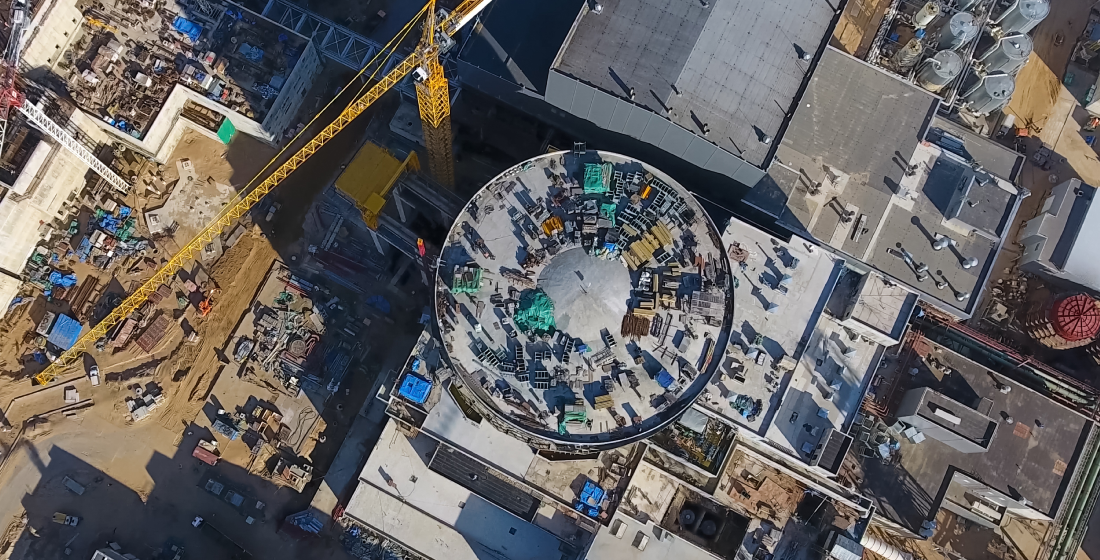What to expect in the coming trade tech revolution
With Sibos 2018 underway, Nancy Amert, director of CGI’s Trade Innovation Lab, and Rory Kaplan, director and offering manager of trade and supply chain at CGI, share their thoughts on how technology is impacting trade finance.

There are many reasons to be optimistic about the future of trade finance. A wave of technological innovation has been building, and when it crests it will change the face of the whole sector, streamlining processes, increasing efficiencies, and opening up potential new avenues of growth.
Rory Kaplan, director and offering manager of trade and supply chain at CGI, is particularly positive about the direction in which trade technology is moving: “Emergent technology is advancing at a much faster pace than we've seen in the past. If you take optical character recognition (OCR) as an example, it’s been around for a long time, but was not as effective as was hoped – especially as it relates to trade documents which can be unstandardized and of poor quality, leading to problems with accuracy of data capture. Now, with the introduction of natural language processing, machine learning, and other techniques that we use for data capture, it has improved in a very short period of time. And that’s just one example.”
Technological innovation is changing trade finance; and changing it fast. If the trade finance future is to be centered around distributed ledger technology, such as blockchain, then the path towards that future is paved by the processes of digitization, and sign-posted with advances in artificial intelligence. These advances allow for an increased pace on this journey.
“Artificial intelligence is widely used today. The technology is proven to a point, but there's still room for improvement. We've spoken to several different organizations that offer these types of solutions, and the ultimate goal is to reach a high enough accuracy when digitizing trade documents that they can be used for sanctions screening – where you really need to be accurate.
“Nobody seems to be at 100% yet, but it's moving in the right direction,” adds Kaplan. "With data capture leading to digitization, the ability to automate the cleansing of the data, and streamline the process becomes easier. The ultimate goal is an end-to-end process that allows you to map data into other systems.”
Trade ripe for new tech
Nancy Amert, director of CGI’s Trade Innovation Lab, concurs: “Trade is ripe for process improvement through the types of emerging technology we’ve seen implemented over the last few years. This provides new opportunities and ways of tackling pressing business needs.
“One of the reasons people are so excited about the prospect of implementing blockchain solutions in trade finance is that the technology is fundamentally based on such different principles that it forces us to rethink the way that organizations, processes, and even markets work. And that has the potential to fundamentally change the way that we think about things like asset ownership, how money is handled, and the way that risk management is conducted. While not everything is going to be put on the blockchain to make it more efficient, it definitely has the ability to help define, or redefine, what is the real business value, and the related process steps that can be streamlined.”
One of the major hurdles on this path is the issue of standardization of data captured from a host of different trade documents. Says Kaplan: “There are different groups approaching this hurdle, because standardization is vital for all areas of trade to eventually interoperate. They have to be working with the same data and the same standards. The ICC and BAFT are working on this, but it will take time. For blockchain to be successful though, standards are extremely important.”

Rory Kaplan: director at CGI
Adds Amert: “I get really excited when I see that bodies such as the United Nations are getting involved in organizing working groups to look at how nations are going to actually leverage blockchain. Companies like Microsoft and IBM have been working on the standards as well. You’re seeing large, important entities across all of society, all global citizens if you will, helping to look at how standards can be developed. The foundational work is already underway to set up an environment for mass adoption.”
There are historical parallels to the implementation of standards. Railroads, electricity, telecommunications have all required the negotiation and implementation of standards in one way or another to move the whole industry forward. Given the size and scale of the global trade finance industry, as well as all of its related sectors, the need for a collaborative environment is extremely important to attempt to avoid the development of digital islands of coexisting standards.
Kaplan mulls: “I think that digital islands are possibly realistic, because we're already seeing different networks forming. If we don't establish, at the very least, base of standards to allow for interoperability, then the digital islands concept becomes a real danger. One potential problem then would be the issue of duplicate invoice financing – if a company approaches a bank with an invoice for financing, and they approach another bank with the same document, any duplication would be picked up on the blockchain. With digital islands, this might not happen outside of a particular network. There are plenty of other examples that underline the need for standards, interoperability, and mass adoption. These are important goals.”
The telecommunications companies went through a similar process in which they were building parallel systems that often did not interact well together. Explains Amert: “Eventually they came together and realized the need for interoperability to ensure that the ‘tech handshakes’ were in place to route a call from one call center to another in a seamless fashion for the customer. It is those types of 'handshakes' in the blockchain and emerging tech space – application programming interfaces (APIs) – that would allow for different digital networks to seamlessly communicate with one another. As long as trade platforms and other new platforms of the future can connect and message via APIs, then end-users will hopefully experience the seamless passage of data and transactions and not end up on a digital island.”
With this in mind, CGI is remaining ‘blockchain agnostic’ and focusing on mapping out APIs to allow for flexible communication between networks and blockchain protocols. Says Kaplan: “What we recommend to banks is to be as interconnected as possible via APIs into the various networks that are forming – for example, the formation of new national trade platforms in Singapore, Hong Kong and Japan.”
He continues: “CGI has re-architected the back-office system and the CGI Trade360 portal is very conducive to this new interconnected world. For example, CGI Trade360 has 2,000 endpoints to which the APIs can connect. We can connect our back-office systems to third party platforms, and our portal to mobile through web service APIs, corporate portals, and even to other portals. APIs are key to interoperability and integration going forward. We are well-positioned with our architecture to accommodate that. Flexibility is key.”
A further challenge is that of moving from proof of concept to scalable implementation – something that seems to be moving at a slow pace. Kaplan says that, at first, he thought this was a problem unique to trade finance, but upon further investigation, discovered that other industries are experiencing similar challenges.
Blockchain patience
“There are not too many commercially viable blockchain solutions out there, and that's a challenge. Why is this happening? How can we resolve some of the issues preventing commercialization? There’s a hesitancy from some that don’t think the platforms are technically viable yet. This is coupled with regulatory pressures and concerns about security on centralized platforms. We need to address these issues and figure out how to move ahead.
“Despite the challenges, CGI shares the belief that blockchain technology will have a major positive impact on trade and supply chain finance; therefore, we are actively involved in several POCs and moving towards commercialization. It may take some time to get there, however the benefits that this technology can bring to our banking clients is why we have taken both an early industry leadership position and why we remain committed on the road towards commercialization,” says Kaplan.
It can be argued that this is simply the logical process of developing new technology – emergence, testing, deployment and mass adoption. With blockchain, there is a degree of impatience for results. But Amert points out that there are success stories: “The ASX Stock Exchange is blockchain-enabled at this point. They started in 2015, so it took about three years, which highlights that it can take a while for these really big initiatives to happen.
“Also, looking ahead, I think the next 12 months will be important and quite interesting, as we are going to see more and more blockchain-enabled product and service offerings come to market. I remain optimistic that the coupling of emerging technologies and process improvement will get us to a ‘new world of trade’ that we have been envisioning and building towards.”
She adds: “If you look at Gartner’s hype cycle, blockchain is just past the peak of inflated expectations, and we are probably headed towards the trough of disillusionment. It's a natural cycle - people have notable skepticism as a reaction to some of the hype surrounding blockchain. However, the proliferation of blockchain protocols – some 1,500 now I believe – suggests that there is still a great deal of optimism, investment and growth.
“We are still in the early days of development and experimentation. We are still learning how blockchain and related technologies can be leveraged and blended with traditional trade approaches. It will be like having one foot in the new world and one foot in the old world. How we straddle this and how key players in the banking industry juggle building solutions incrementally without missing core value proposition and cash flow considerations are a good example of what we call ‘practical innovation’ at CGI.

Nancy Amert: director at CGI
“We want to build a future global trade eco-system that is streamlined and accelerated. In 10 years, we’ll look back over our shoulders in disbelief that so much time, energy and resources were tied up in disjointed, disparate, uncoordinated, paper-bound processes. It may take another 10 years after that to get the 'network effect' and to really see the benefits ripple across all trade participants – but we’re on that road now – we’re heading in the right direction.”
Amert ended by saying. “Imagine how much faster, easier, trackable, and traceable transactions will be and then consider how much more knowledgeable - more intelligent – the future trade worker and the bank executive/ decision maker will be with enhanced data and highly-filtered, multiple-referenced information at their fingertips.”
She explained that workers will be using something like a Blockchain Explorer the way we use Internet Explorer today. “The speed of business will be accelerated and that is good for corporate cash conversion cycles, and that will bubble up to overall global economic improvement and growth.”
Amert pondered: “Blockchain may not save the world, like some people have hyped – but it will probably help reduce bank and regulatory risk on many levels and probably eliminate more than a few common customer headaches – like 'Whatever happened to my L/C?' and 'Why, in heaven’s name, is it taking so long?'”





